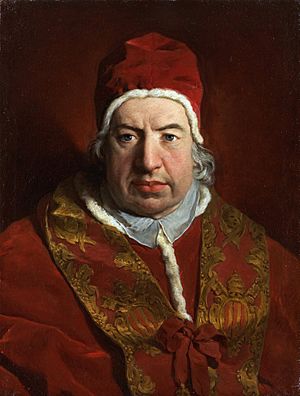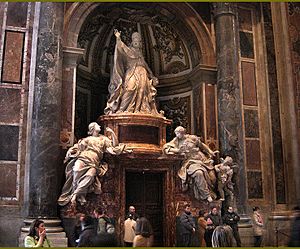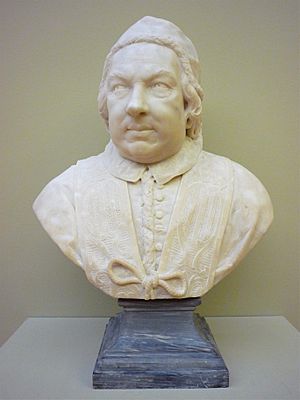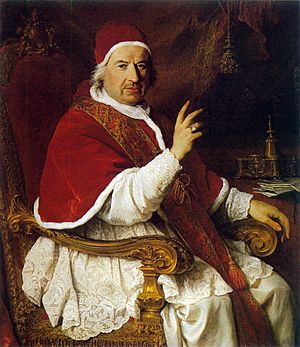Pope Benedict XIV facts for kids
Quick facts for kids Pope Benedict XIV |
|
|---|---|
| Bishop of Rome | |

Portrait of Benedict XIV by Pierre Subleyras, 1746
|
|
| Church | Catholic Church |
| Papacy began | 17 August 1740 |
| Papacy ended | 3 May 1758 |
| Predecessor | Clement XII |
| Successor | Clement XIII |
| Orders | |
| Ordination | 2 July 1724 |
| Consecration | 16 July 1724 by Benedict XIII |
| Created Cardinal | 9 December 1726 (in pectore) 30 April 1728 (revealed) |
| Personal details | |
| Birth name | Prospero Lorenzo Lambertini |
| Born | 31 March 1675 Bologna, Papal States |
| Died | 3 May 1758 (aged 83) Rome, Papal States |
| Previous post |
|
| Motto | Curabuntur omnes (Latin for 'All will be healed') |
| Coat of arms |  |
| Other Popes named Benedict | |
Pope Benedict XIV (born Prospero Lorenzo Lambertini; 31 March 1675 – 3 May 1758) was the head of the Catholic Church. He was also the ruler of the Papal States from 1740 until his death in 1758.
Benedict XIV was known as a very smart and learned leader. He supported science, art, and the study of the human body. He worked to follow the rules set by the Council of Trent, an important meeting of the Church. He also tried to reduce the power of non-religious ideas in European governments.
During his rule, he made some changes to taxes in the Papal States. He also encouraged farming and free trade. He created new museums, which are now part of the Vatican Museums. He was interested in many subjects, like old literature, church books, and art. This makes him a bit like a polymath, someone who knows a lot about many different things.
Towards the end of his time as pope, he faced problems with the Society of Jesus, also known as the Jesuits. He had to remove them from Portugal in 1758, just before he died. This was because King Joseph I of Portugal wanted them out.
The writer Horace Walpole described him as someone "loved by Catholics, respected by Protestants." He called him "a priest without pride or greed, a prince without favorites, a pope without showing special favor to family, an author without showing off, a man whom neither smarts nor power could make bad."
Contents
Early Life and Education
Birth and Studies
Prospero Lorenzo Lambertini was born into an important family in Bologna, Italy. Bologna was the second-largest city in the Papal States at that time. He was the third of five children.
He first studied with private teachers. Then, he went to the Convitto del Porto, a school run by the Somaschi Fathers. At age 13, he started attending the Collegio Clementino in Rome (1689–1692). There, he studied public speaking, Latin, philosophy, and theology. He especially loved reading the works of St. Thomas Aquinas.
Later, he became very interested in civil and church law. In 1694, at 19, he earned degrees in both sacred theology and law.
Church Career
Lambertini began his career helping important church officials. In 1701, after Pope Clement XI was elected, he became a church lawyer. Soon after, he became an advisor to a major church group called the Supreme Sacred Congregation of the Roman and Universal Inquisition. In 1708, he became a "Promoter of the Faith." This job meant he helped decide if people could become saints.
As Promoter of the Faith, he had two big successes. He helped with the process to make Pope Pius V a saint. He also wrote an important book about how people become saints.
In 1712, Lambertini became a church theologian and a member of the Sacred Congregation of Rites. In 1713, he was named a monsignor. In 1718, he became secretary of the Sacred Congregation of the Council.
On June 12, 1724, Pope Benedict XIII made Lambertini a bishop. He was consecrated (made a bishop) in Rome on July 16, 1724, by Pope Benedict XIII himself. In 1725, he worked as a church law expert at a meeting led by Pope Benedict XIII.
In 1725, Bishop Lambertini paid for a chapel in Bologna to be painted. He ordered a painting for the main altar showing the Virgin Mary being greeted by an angel.
He became the Bishop of Ancona in 1727. He was allowed to keep his title of Archbishop and his other church jobs. He also continued to be the head of a monastery. As pope, he remembered Ancona and sent gifts to its church every year.
Becoming a Cardinal
Bishop Lambertini was made a Cardinal on December 9, 1726. This was announced publicly on April 30, 1728. He was given the church of Santa Croce in Gerusalemme in Rome. He took part in the 1730 election for a new pope.
On April 30, 1731, Cardinal Lambertini was made Archbishop of Bologna by Pope Clement XII. While he was archbishop, he wrote a long book about church meetings called diocesan synods. He was preparing to hold his own synod in Bologna. He remained Archbishop of Bologna even after becoming pope, finally stepping down in 1754.
Election to Pope
After Pope Clement XII died on February 6, 1740, Cardinal Lambertini joined the meeting of cardinals to choose the next pope. The meeting started on February 18, but Lambertini arrived on March 5. He was not expected to be chosen, as he wasn't a favorite of any of the main groups of cardinals.
The election lasted for six months. Many cardinals were considered, but none could get enough votes. In mid-August, Cardinal Annibale Albani suggested Lambertini as a compromise choice. It is said that Lambertini told the cardinals, "If you wish to elect a saint, choose Gotti; a statesman, Aldrovandi; an honest man, me." Gotti was a philosophy professor, and Aldrovandi was a law expert.
This clever remark seemed to help him. People also respected his deep knowledge, kindness, and ability to find solutions. On the evening of August 17, 1740, after 255 votes, he was elected pope. He chose the name Benedict XIV to honor Pope Benedict XIII, who had helped his church career. He was officially crowned on August 21, 1740.
As Pope
Benedict XIV's time as pope began with many challenges. There were arguments between Catholic rulers and the papacy (the pope's office) about who should choose bishops. He managed to solve most of these problems with countries like Naples, Sardinia, Spain, Venice, and Austria.
Church Rules and Finances
On March 30, 1741, Benedict XIV issued a new church law called Pastoralis Romani Pontificis. This law restated old rules, including that members of Protestant groups were not part of the Catholic Church. It also said that church councils should not be used to go against the pope's decisions.
When Benedict XIV became pope, the papal government was deeply in debt. He tried to improve the finances of the Papal States. He reduced the size of the papal army, which was no longer very effective. He also cut costs in his own household and in the government. He tried new taxes, but they didn't always work as planned. He lowered taxes on some goods but added new taxes on others.
Despite money problems, the Papacy bought two ships from England. In 1745, Benedict personally named a new ship, the Benedetta. He also ordered improvements to the harbor of Anzio, but the work was too expensive and stopped in 1752.
He encouraged farming and free trade. He also cut military spending. He tried to fix the government, which still had problems from earlier popes. At the University of Bologna, he brought back the study of anatomy and created a new position for surgery. He understood church problems well and respected different ideas.
Other Important Actions
On December 22, 1741, Benedict XIV issued a rule against the enslavement of native peoples in the Americas and other countries. This rule said that anyone who enslaved a native Brazilian would be removed from the Church. However, it did not talk about the enslavement of black Africans. The rule also told the Jesuits to stop trading and getting involved in politics. This rule was not always followed in Brazil.
In 1741, another church law was made. It gave the Supreme Sacred Congregation of the Roman and Universal Inquisition the job of protecting the holiness of the sacrament of confession.
On May 18, 1743, Benedict XIV wrote to the bishops of Poland about marriage. He was unhappy that Christian marriages were being ended too easily by church courts in Poland. He also addressed "secret marriages," which were private agreements between partners.
Benedict XIV also helped to create a catalog of old Eastern manuscripts in the Vatican Library. He added about 3,300 of his own books to the collection. During his time, other large collections of old books and manuscripts were also added to the Vatican Library.
In 1747, Benedict issued a rule called Postremo mense superioris anni. This rule explained Catholic teaching on infant baptism. It said that usually, a Jewish child should not be baptized without their parents' permission. However, if a Jewish child was in danger of dying, they could be baptized without permission. If such a baptism happened, the church had a duty to take the child from their parents to give them a Christian education.
Eastern Rites
Benedict XIV was involved in issues about missions, both for converting non-Christians and for bringing other Christian groups back to the Roman Church. He helped Coptic Christians in Egypt who had joined the Roman Church but had no bishop. In 1741, he gave special powers to the Coptic Patriarch of Jerusalem to care for these Christians.
In 1755, he wrote an encyclical (a letter from the pope) called Allatae Sunt. This letter addressed problems faced by missionaries working with different Eastern Christian groups, especially Armenian and Syriac rites.
Benedict XIV also banned women from serving the priest at the altar. He noted that this practice had spread to some Eastern Christian groups.
Chinese and Indian Rites

Benedict XIV had a very busy time as pope. He reformed how priests were educated and how the church's calendar of feasts worked. One of his most important actions was creating new rules for Christian missions in two important documents: Ex quo singulari (1742) and Omnium sollicitudinum (1744).
These rules dealt with how missionaries, especially Jesuits, used local customs and words to explain Christian ideas in India and China. For example, there was a debate about honoring ancestors. Was it unacceptable "ancestor worship" or more like the Catholic veneration of saints? This was especially tricky if the ancestor was not Christian. The choice of a Chinese word for the name of God had also been discussed for a long time. Benedict XIV said these practices were not allowed. As a result, many converts left the church.
During his papacy, Benedict XIV asked architects to design a large new palace. It was meant to be grander than another famous palace in Caserta. This palace was planned for south of St. Peter's Basilica but was never built. On December 15, 1744, Benedict XIV blessed a beautiful chapel in Rome. This chapel, with its mosaics made of precious stones, was later shipped to Portugal.
The Capuchin monks, led by Joseph Mary Bernini, helped grow the Christian community in Bettiah, India. This was supported by Pope Benedict XIV in a letter to the local king in 1742.
New Cardinals and Saints
Benedict XIV appointed 64 new cardinals during his time as pope. One of them was Henry Benedict Stuart. The pope also named seven new saints, including Camillus de Lellis and Fidelis of Sigmaringen. He also recognized several people as "blessed," like Charlemagne.
Holy Year
On May 5, 1749, Pope Benedict XIV announced a Holy Year, which would begin on Christmas Eve, 1749, and last through 1750. During April 1750, 43,000 meals were given to the poor at a hospital. Later that year, the Pope banned card games.
For the Holy Year, Benedict XIV asked Saint Leonard of Port Maurice to preach. The pope also called for Christian unity and made sure pilgrims coming to Rome had places to stay.
Following Saint Leonard's advice, the pope was the first to set up the Via Crucis (Stations of the Cross) at the Colosseum. He made the Colosseum a holy place to remember early Christians who died there. The Stations of the Cross were removed in 1874 but put back in 1925.
Personality
Benedict XIV was seen as one of the smartest popes. He was known for his sharp mind and good character. He was also very humble. When Horace Walpole sent him a statue with a special message, Benedict XIV smiled and said, "Alas! I am like the statues of the Piazza San Pietro — wonderful from far away but ugly up close!"
However, Benedict XIV also had some personal flaws. He enjoyed playing cards and was known for using bad language sometimes. But he was a very religious man. He had a crucifix in every room, and it is said that seeing a crucifix often helped him control his language.
Despite his faults, Benedict XIV was cheerful and clear-minded until the very end. People who knew him said his blue eyes sparkled with humor and friendliness.
Death and Burial

Benedict XIV had suffered from kidney problems for many years. His health got worse in 1758. After a struggle with gout, he died on May 3, 1758, at 83 years old. His last words to those around him were, "I leave you in the hands of God." He is also said to have recited the famous Latin phrase "Sic transit gloria mundi" (Thus passes the glory of the world) and added, "I now fall into silence and forgetfulness, the only place that belongs to me."
Benedict XIV first showed signs of serious illness on April 26, 1758. His condition quickly got worse in the following days as his gout and kidney disease caused him more pain. Even so, he kept his appetite, which some thought was a sign he might get better. But by May, his health had declined greatly. He remained clear-headed until the end and was able to give one last blessing before he died on May 3.
After his funeral, he was buried in Saint Peter's Basilica. A large special structure was built in his honor.
See also
 In Spanish: Benedicto XIV para niños
In Spanish: Benedicto XIV para niños
- Apostolicae Servitutis
- Cardinals created by Benedict XIV
- List of popes
- Suppression of the Jesuits
- Encyclical Vix pervenit




